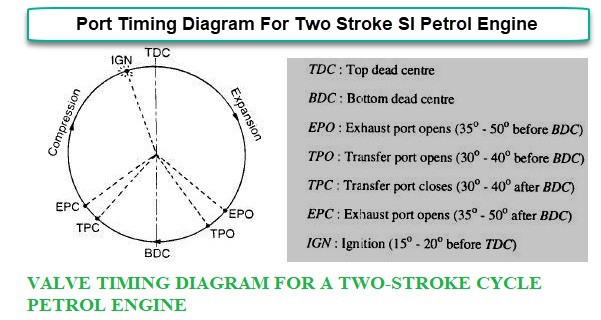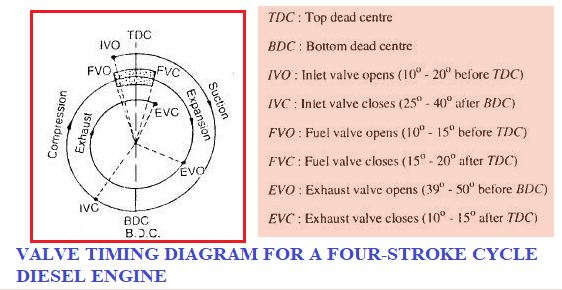Difference Between Two Stroke and Four Strokes | |
Two Strokes | Four Stroke |
| It has two revolutions of the crankshaft during one power stroke |
ii. It generates high torque | It generates less torque |
iii. Its uses port for fuel’s outlet and inlet | It uses valves for outlet and inlet of a fuel |
iv. Its engines result in lesser thermal efficiency | Its engines result in higher thermal efficiency |
v. It has a larger ratio in terms of power to weight | It has a lesser ratio in terms of power to weight |
vi. It generates more smoke and shows less efficiency | It generates less smoke and shows more efficiency |
vii. Requires more lubricating oil as some oil burns with the fuel | Requires less lubricating oil |
viii. Due to poor lubrication, more wear and tear occurs | Less wear and tear occurs |
ix. Engines are cheaper and are simple for manufacturing | Engines are expensive due to lubrication and valves and are tough to manufacture |
x. Engines are basically lighter and are noisy | Engines are basically heavier because its flywheel is heavy and are less noisy |
S.no | Parameter | SI Engine | CI Engine | ||||
1. | Definition | It is an engine in which the spark is used to burn the fuel. | It is an engine in which heat of compressed air is used to burn the fuel. | ||||
2. | Fuel used | Petrol is used as fuel. | Diesel is used as fuel. | ||||
3. | Operating cycle | It operates on Otto cycle. | It operates on Diesel cycle. | ||||
4. | Compression ratio | Low compression ratio.(6 to 10) | High compression ratio.(15 to 25) | ||||
5. | Thermal efficiency | Low thermal efficiency because of low compression ratio .Up to 26 %. | High thermal efficiency because of high compression ratio up to 40%. | ||||
6. | Method of ignition | Spark plug is used to produce spark for the ignition. | Heat of compressed air is used for the ignition. | ||||
7. | Engine Speed | High speed engines. | Low speed engines. | ||||
8. | Pressure generated | Low pressure is generated after combustion. About 10 bar | High pressure is generated | ||||
9. | Constant parameter during cycle | Constant volume cycle. | Constant pressure cycle. | ||||
10. | Intake | Air + fuel. | Only air. | ||||
| Weight of engine | Si engine has less weight. | CI engine are heavier. | ||||
12. | Noise production | It produces less noise. | It produces more noise. | ||||
13. | Production of hydrocarbon | Less Hydrocarbon is produced. | More hydrocarbons is produced. | ||||
14. | Starting | The starting of SI engine is easy. | The starting of CI engine is difficult. | ||||
15. | Maintenance cost | Low | High | ||||
16. | Vibration problem | Less | Very High | ||||
17. | Cost of engine | Less cost | High cost | ||||
18. | Volume to power ratio | Less | High | ||||
19. | Fuel supply | carburettor | Injector | ||||
20. | application | It is used in light commercial vehicles like motorcycle, cars. | It is used in heavy duty vehicles likes bus, trucks, ships etc. | ||||
|
|
There are different kind of efficiency are there
Indicated power (I.p): brake power + friction power The indicated power (I.P.) of the engine can be calculated as follows:
I..P. = (pm x 105 x L. x A x N x n x k )/60
Pm = Inicated mean effective pressure in bar L = Length of stroke in metre A = Piston areas in m2 N = Speed in R.P.M. n = Number of working stroke per minute. n = 1 for two stroke engine n= 1 / 2 for four stroke engine k= number of cylinders
ii. Brake power ( B.P): The power available at crankshaft is called brake power . it is measured by means of brake mechanism either prony or rope brake. For prony brake = 2 Π N T / 60 Watt For rope brake =(w-s) Π (D+d)N / 60
iii Mechanical efficiency : it is ration of brake power to indicated power Efficiency = B.P / I.P i.v Indicated thermal efficiency : It is the ration of indicated work done to the energy supplied by the fuel . η (ith)= I.P (KJ/s)/ energy in fuel per second (KJ/s) = I.P / mf x cv V Brake thermal efficiency: It is the ratio of power obtained at shaft to the energy supplied by fuel. η (b.t.e)= B.P (KJ/s)/ energy in fuel per second (KJ/s) = B.P / mf x cv Vi Air standard efficiency : It is the ratio of work output to heat input For petrol η = 1- 1/ ry-1 For diesel η = 1- 1/ ry-1 [ py-1 / y(p-1) ] Where p = cut off ratio = v3 / v2 . |
Given T1=35oC=308 K P1=0.1 Mpa T3=1100oC=1373 K r=v1/v2=7
(a) The temperature and the pressure at various points in the cycle,
we know that P2/P1 = (V1 /V2)y = 71.4 Hence, P2=1524 k Pa We also know that T2 / T1 = (V1/V2) y-1 = 71.4 We get T2=670.8 K For process, 2-3, P2V2 / T2 = P3V3 / T3 P3 = T3 P2 /T2 P3 = 1373 X 1524 / 670.8 P3 = 3119.34 kPa Process 3-4 is isentropic T3/T4 = (V4 /V3)y-1 = 71.4-1 T4 = 1372 / 2.178 T4 =630.39 K
(b) The heat supplied per kg of air,
Heat input = Qin= cv (T3-T2) =0.718(1373–670.8) = 504.18 kJ/kg
Heat rejected = Q out= cv(T4-T1) =0.718(630.34–308) = 231.44 kJ/kg
(c) Work done per kg of air,
The net work output Wnet=Qin-Qout The net work output, Wnet=Qin-Qout =272.74 kJ/kg
(d) The cycle efficiency
Thermal efficiency, ηth otto=Wnet/Qin =0.54 =54 % Otto cycle thermal efficiency, ηth,otto =1-1/rγ-1 = 1-1/70.4 = 0.54 or 54 %
v1=RT1/P1 =0.287 x 308 / 100=0.844 m3/kg (e) The MEP of the cycle MEP = Wnet/(v1–v2) = 272.74/v1 (1-1/r) =272.74/0.844(1-1/7) =360 kPa |
Given T1 = 27°C = 300 K P1 = 100 kPa rp = 6.25 T3 = 800°C = 1073 K Since process, 1-2 is isentropic, T2/T1 = (rp) y-1/y =6.25 1.4-1 /1.4 = 1.689 T2 = 1.689 X 300 = 506.69 K
(a) The compressor work per kg of air
W comp= cp(T2-T1) = 1.005(506.69-300) = 207.72 The compressor work per unit kg of air is 207.72 kJ/kg
Process 3-4 is also isentropic, T3/T4 = (rp) y-1/y = (6.25 )1.4-1 /1.4 = 1.689 T4 = T3 / 1.689 = 1073 /1.689 = 635.29K
(b) The turbine work per kg or air
W TURB = cp(T3-T4) = 1.005 (1073-635.29) = 439.89 KJ.Kg
The turbine work per unit kg of air is 439.89 kJ/kg (c) The heat supplied per kg
Heat input, Qin = cp(T3-T2) = 1.005(1073-506.69)
Heat input per kg of air is 569.14 kJ/kg
(d) The cycle efficiency Cycle efficiency, ηth = (Wturb-Wcomp)/Qin =(439.89-207.72)/569.14 =0.408 or 40.8% |
Diameter of the piston d= 150 mm Stroke length L= 180 mm Clearance volume Vc = 0.89 litre RPM of the engine N = 300 Indicated mean effective pressure pm= 6.1 bars Gas consumption m. = 6.1 m3/h Calorific value of the gas (fuel) CF = 17000 kJ/m3 Determine the followings: a) Air Standard Efficiency b) Indicated power (IHP)developed by the engine c) Indicated thermal efficiency of the engine
|
Swept volume Vs = πd2L/4 = π(0.150)2 x 180/4 = 0.00318 m3
Clearance volume Vc= 0.00089 m3
Total volume = Swept volume + clearance volume
= 0.00318 + 0.00089 = 0.00407 m3
Compression ratio γ = Total volume/Clearance volume
= 0.00407/0.00089 = 4.573
a) Air standard Efficiency η = 1 –1/(r)γ—1 = 1—1/(4.573)1.4—1 = 0.456 = 45.6 %
b) Indicated power IHP = 100 pLAN/60 When p is in bars = 100 x 6.1x 0.180 x [π(0.150)2/4] 300/60 = 9700 W
(c ) Indicated Thermal Efficiency
ηit = Indicated power in (kJ/s)/Heat supplied in (kJ/s)
= (9700/1000)/(6.1 x 17000/3600) = 0.3367 = 33.67 %
|
Air fuel ratio 15.5: 1 Calorific value of fuel 16000 kJ/kg Air Standard Efficiency: 53% Mechanical Efficiency: 80 % Indicated Thermal Efficiency: 37 % Volumetric Efficiency: 80 %
Stroke/bore ratio: 1.25
Suction pressure: 1 bar
Suction Temperature: 270C
RPM: 2000
Brake Power: 72 kW
Calculate the followings:
a) Brake specific fuel consumption b) Bore and stroke |
Find compression ratio from air standard efficiency
η = 1 –1/(r)γ—1
0.53 = 1 –1/(r)1.4—1
r = 6.6
IHP = BP/Mech efficiency = 72/0.80 = 90 kW
ηit =IHP/(Sp.Fuel Consp x Cal value)
0.37 = 90/sfc x 16000
sfc is specific fuel consumption
sfc = 0.0152 kg/s
a) Brake specific fuel consumption
Brake sfc = sfc IHP/BP = 0.0152/72 =0.00021 kg/s /kW
Brake sfc = 0.7601 kg/kWh
b) Bore and stroke
Bore and stroke of the engine Mass of air fuel mixture/kg of fuel = 15.5 +1 = 16.5
Mass of fuel supplied to the engine = 0.0152 x 16.5 = 0.2508
Volume of air fuel mixture = mRT/p =0.2508 x 287 × 300/ (1×105)
V = 0.2159 m3/s
Swept volume = volume of mixture supplied/vol efficiency
Vs = 0.2159/0.80= 0.2699
Vs = (πd2L/4) n x (rpm/2) /60
Where n is the number of cylinders
= (πd2 x 1.25 d/4)n rpm/120
d= 0.152 m= 152 mm
L = 190 mm |
Maximum efficiency of a Carnot engine e max = (Thigh – Tlow)/Thigh If emax = 0.3, then 0.3 = 1 – (473 K)/Thigh Thigh = 473/0.7 = 675.7 K = 402.7 oC
|

